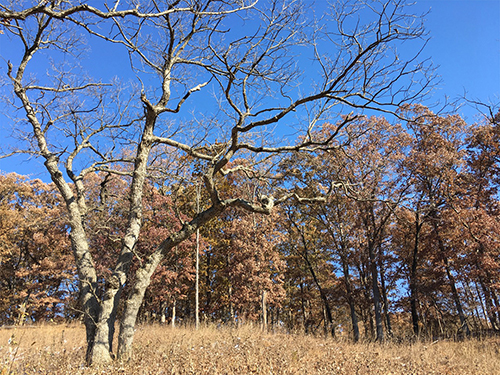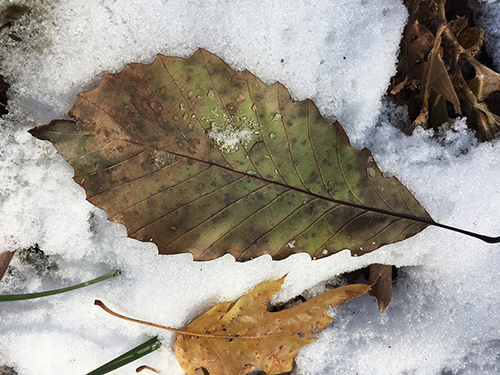
This Chinquapin oak tree grows in the hill prairie at Singing Woods Nature Preserve. Using a thin, hollow drill, a bore sample was taken and analyzed. The sample indicated the tree is 381 years old. The tree heals over quickly after the sample is removed. Chinquapins have been referred to as the Sequoias of the Midwest. (PHOTO BY MIKE MILLER)

MIKE MILLER
As the leaves fall and the forest takes on a slumbering personality, we often don’t think much about the trees until they start leafing out again in the spring. However, winter is a great time to take a new look at trees and get to know them for their shape and growth form. Some stand tall and stark against the winter sky. An observant hiker will notice an array of different colors of bark, or the variety of patterns that different tree species possess. Many of these traits are overlooked in the summer when the trees are adorned with leaves, but to me, the tree’s true character becomes evident during the winter.
While hiking along any hill prairie in our region, the visitor is sure to see a tree loaded with character –– the Chinquapin Oak (Quercus muehlenbergii). The name might seem like a tongue-twister, but “Ching-Ka-Pin” is easy enough to pronounce. The root of the word goes back to the Algonquin language. There are other trees that share a similarly-spelled version of this Algonquin word; the Ozark Chinkapin, and the Allegheny Chinkapin. While these trees are more closely related to the American Chestnut, all of these trees share a similar leaf shape, so they all share similar common names. Another reason not to judge a tree by its leaf-cover.
Our Chinquapin Oaks are true niche specialists in the preference of where they like to grow. Along the bluffs of the Illinois River, they will be found branching out over glacial drift hill prairie opening. They like alkaline soils with a pH of greater than 6.5, are extremely drought tolerant and tolerant of fire due to their corky bark. When found in these conditions, they are extremely slow-growing. So, a rather small Chinquapin can be hundreds of years older than a similar sized tree of a different species. Their growth pattern often has a “Bonsai” quality due to the slow growth and poor soil conditions.
One such tree grows in the hill prairie in Singing Woods Nature Preserve. We were curious about its age, and several years ago, Mike Ingram took an increment bore sample to get its age. This is a thin, hollow drill that removes a sample of wood so that the rings can be counted. The tree quickly heals over. This particular tree turns out to be 381 years old. This would put its first year of growth back to 1638. That is a significant year. It marks the end of the Pequot War, where the New England colonists of the Massachusetts Bay, Plymouth, and Saybrook colonies, basically massacred the Pequot tribe. That year over 700 Pequots were killed or captured. Survivors were sold off as slaves to the West Indies, or dispersed as captives to tribes aligned with the colonists. So, our tree with an Algonquin derived name, dates back to a dark period in the history of many Algonquin speaking people.
The acorns of Chinquapin Oak are rather small, but it has less of the acidic tannins that are found in many other species of oaks, so it is relatively easy to process the nuts into a meal or flour to be used as food. Chinquapin acorns were often found in the midden pits of local archeological sites, so we know they were used as a food source for thousands of years.
The next time you visit our parks and walk by a hill prairie, take a look for an old, gnarled tree standing sentinel over a copse of prairie grass. Imagine what this tree has experienced in its lifetime. Get to know some of our trees as they shed their summer cloaks of leaves. You just might be surprised to find out that this is the perfect time of the year to rethink how we experience the natural world.

Leaf of a Chinquapin oak. After leaves have fallen in autumn, trees can more easily be identified by their branching and bark structure. (PHOTO BY MIKE MILLER)
